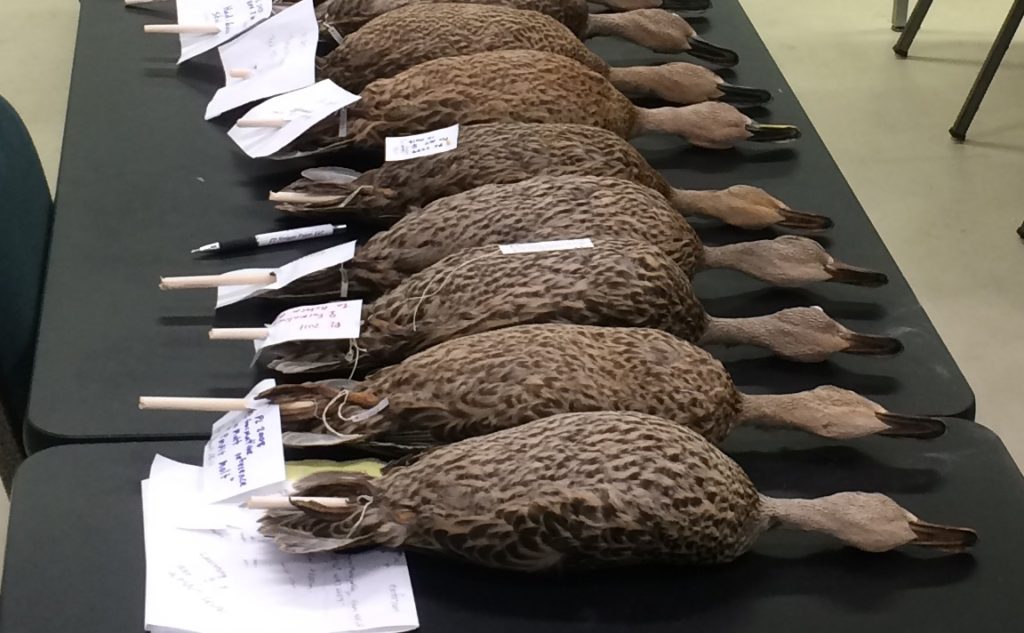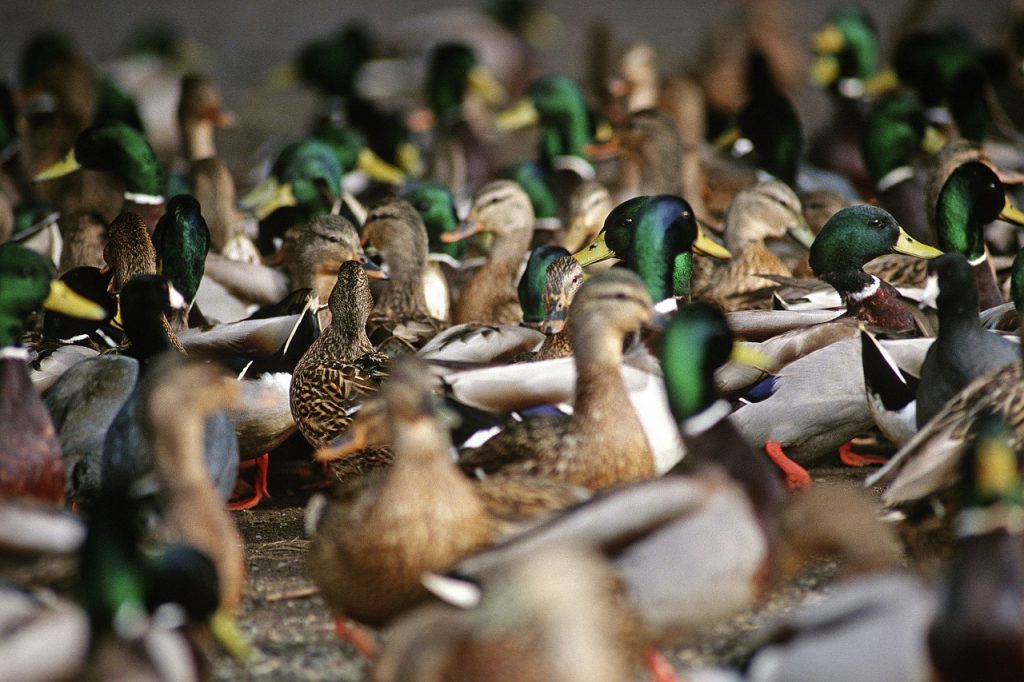The Mallard Take-Over
Flecks of green on the heads of Mexican ducks. A white bar spanning the wing of a North American black duck. A mottled duck with black tail feathers.
For years, when waterfowl biologists spotted ducks with mallard-like traits like these, they dismissed them as hybrids.
After all, with mallard populations straddling 12 million and spanning much of the continent, it was plausible that they were mating with other duck species, and in the process, passing on some of their mallard characteristics to their offspring.
It was a trend that concerned some wildlife managers, who worried mallards’ amorous intermingling with other species would decrease diversity and that smaller populations of birds would soon become genetically extinct.
Species like the Mexican duck, whose population numbers rest between 40,000 to 50,000.
But what if mallard hybridization is less common than earlier thought, or there are “built in” ways that ducks (or other species) lessen the effect of hybridization?
It’s a question Philip Lavretsky set out to answer. Lavretsky, now an assistant professor of biological sciences at the University of Texas El Paso, has two passions: genetics and waterfowl. For the past seven years, he’s married those interests to learn more about North American ducks. In 2011, Lavretsky received an Institute for Wetland and Waterfowl Research (IWWR) fellowship, which supported his graduate pursuits. On top of this, his subsequent research paper earned him the 2015 Ducks Unlimited Canada IWWR Student Publication Award.
It’s a point of pride among waterfowlers and birders to spot a duck and identify it based on its appearance. Tell-tale features like plumage, body and flight composition tell us if we’re looking at a blue-winged teal or gadwall. But sometimes, identifying waterfowl can be difficult, especially if they have traits that are indicative of two different species.
Although geneticists had some success differentiating distantly related species, they weren’t having much luck drawing a distinction between more closely related species, like those within the mallard complex. The mallard complex refers to a group of closely linked species of mallard-like ducks found around the world and believed to be decedent from a species originally from Africa.
“You could see in your hand what [mallard-like] species the feather had come from. There are clear phenotypic differences. But you’d look at the genome and you just couldn’t find it,” says Lavretsky. Present in nearly every living organism, genomes are complete sets of genetic instructions, made up of deoxyribonucleic acid (DNA).
“Picture this, ducks have genomes that say they’re a duck. And across the board, genetically, they’re very similar. But then, there’s genes that differentiate them. Genes that make a mallard’s head green and that give a cinnamon teal a blue beak,” says Lavretsky. While he knew genes causing these differences had to exist, in 2009 they still hadn’t been found.
In 2009, Lavretsky, then a PhD student at Wright State University tried to solve that problem using new genomic techniques. He documented his work in a 2015 research article that Ducks Unlimited Canada (DUC) recognized with the Institute for Wetland and Waterfowl Research (IWWR) student publication award.
In his work, Lavretsky collected and analyzed genetic samples from mallards and Mexican ducks.
According to the American Ornithologist’s Union (AOU), Mexican ducks are a mallard subspecies. In the world of taxonomy this means that Mexican ducks are too similar to mallards to be considered their own species, but different enough that they can’t go by the same name.
Through research, Lavretsky discovered that while Mexican ducks are almost genetically identical to mallards, there’s an important divergence in the Z chromosome.
It was a ground-breaking discovery.
Avian species, like humans, have two sex chromosomes. But unlike humans, who have X and Y sex chromosomes, birds have Z and W sex chromosomes. According to the Haldane rule, proposed by British evolutionary biologist John Haldane in 1922, the earliest signs of speciation (the evolutionary process that leads to the creation of new species from existing ones) begin with a divergence in the sex chromosome.
“We’re repeatedly finding similar patterns of Z-sex chromosome divergence when comparing other species within the mallard group, as well as in other closely related waterfowl groups,” says Lavretsky.
And so while Mexican ducks share a genetic history with mallards, over time they’re becoming increasingly unique, as reflected in their darker, all brown plumage. “What we’re finding, in my opinion, is that these [mallard-like] traits are part of the genome and it’s a random effect…a result of recent ancestry with the mallard,” says Lavretsky.
“It’s not always easy to assume that certain traits are indicative of hybrids, as these can be shared within the group for some time,” he adds. But that doesn’t mean hybridization isn’t happening. “We know it occurs,” he says. It’s the frequency at which it happens that his findings call into question.

To further his research, Lavretsky is now working towards publishing data that indicates there are tell-tale markers in the genome that reveal if a bird is a hybrid.
“By using genetic techniques that allow access to larger portions of a genome, we are able to assess which traits are associated with genetically assigned hybrids. This refines our understanding and identification of plumage characteristics that are truly indicative of hybrids,” he says.
A method developed by his colleagues and published recently in Wildlife Society Bulletin (“Is it a mottled duck? The key is in the feathers”), allowed the researchers to correctly identify nearly 90 per cent of the mallards, mottled ducks, and their hybrids they examined. Moreover, they found that a trait (presence/absence of white on the wing) that at one time was used to identify hybrids is in fact a characteristic found in approximately 10 per cent of the Florida mottled duck population and not necessarily linked with hybrid status.
Combined with Lavretsky’s work on speciation in Mexican ducks, the findings could have important implications in the conservation realm.
“We’ll be able to understand if there are certain regions that are more impacted by hybridization, and if so, we can decide what to do to mitigate that,” says Lavretsky.
That interests DUC’s director of conservation science, David Howerter. “DUC has a philosophy to try and maintain the diversity of species out there. So understanding the processes is important,” he says.
Studying speciation in waterfowl is a relatively new field that began in the late 1980s. And looking at duck DNA is even more recent. “A lot of work with mitochondrial DNA was undertaken in the 1990s. The problem was that it was continuously inconclusive,” says Lavretsky. However, as the science around genetics continues to evolve and become more affordable, he sees it gaining importance.
“It’s hard to decipher and understand genetics, but the wildlife world can greatly benefit from what we’re able to do with the genomic perspective. We can ask a lot of question that translate to work on the ground,” says Lavretsky.
Philip Lavretsky was the 2011 recipient of the IWWR Bonnycastle Fellowship in Wetland and Waterfowl Biology. He was also one of two recipients of the 2015 IWWR Student Publication Award. This award is given to raise awareness of the IWWR student program, reward students for successfully publishing their research, and to recognize publications that make a significant contribution to waterfowl and wetland research.



